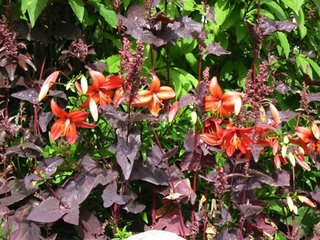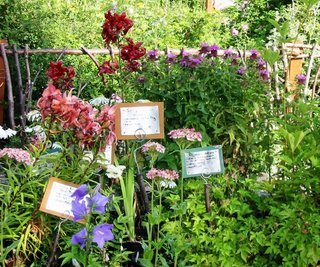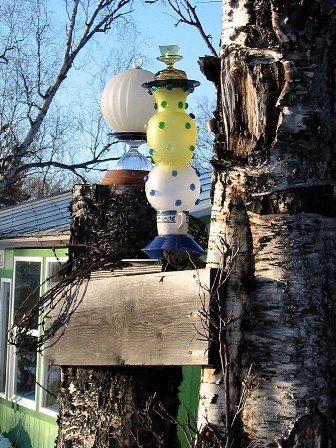Dirt Diva Two
& Atriplex hortensis
There are references to chocolate, gardening, and flowers galore! Well, not actual food chocolate, but, plants the color of chocolate and some that smell like chocolate. Apparently, chocolate is the ‘new’ black - the ‘in’ color for modern gardeners. Browns, tans, black, wines, and maroon, all make up the more flexible dark gothic colors of the chocolate garden scheme. They even had a chocolate garden at the 2005 Chelsea Flower Show inspired by Willie Wonka and the Chocolate Factory. The Roald Dahl Foundation Chocolate Garden, designed by John Carmichael, had cocoa pod-like gravel and a water fountain that seemed to flow with chocolate. Hmm. Chocolate scented and colored flowers? Okay, I’ll bite. Let’s see what will grow in our zone 3 gardens shall we?
I know my Columbines, the black and white Aquilegia vulgaris ‘William Guinness’, and the deep wine ‘Ruby Port’ will qualify. Aquilegia viridiflora ‘Chocolate Soldier’ actually smells like chocolate, but, it’s only about ten inches tall, so, you’ll have to get down on your knees to enjoy it! The Sweet William, Dianthus barbatus, ‘Sooty’ is almost black with deep purple flushed foliage and would look lovely paired with the columbines. Bugleweed, Ajuga ‘Chocolate Chip’ or ‘Caitlin’s Giant’ have deep chocolate colored foliage and pretty blue spikes of flowers. Don’t forget the Heuchera family which has many dark wine to almost black-leaved members like ‘Chocolate Ruffles,’ ‘Palace Purple’, or ‘Plum Pudding.’ Throw some butterscotch on top with the hot gold Heuchera ‘Marmalade’ for a mouth watering effect.
The tall Hollyhock Alcea rosea ‘Nigra’ has satiny black flowers which are beautifully set off by annuals like deep gold or wine red sunflowers (for a photo see August 10th posting on www.woolwood.blogspot.com), deep burgundy sweet pea ‘Midnight’, the black bachelor’s button ‘Black Ball’, and Nasturtiums ‘Black Velvet’ or ‘Mahogany.’ Asiatic lilies like deep maroon 'La Toya' or 'Nerone', the white ‘Tinos’ with her deep carmine throat, or chartreuse ‘Latvia’ with a maroon stardust pattern will look lovely as well. Add some contrast with golds and yellows for a hot look. For a cooler effect try annuals like white Borage and Cosmos or the perennials Thalictrum rochebrunianum, a tall meadow rue with delicate lilac rose flowers and the white
Monkshood ‘Ivorine’ and shell pink ‘Carneum roseum’.

Berberis thunbergia 'Crimson Velvet'
If you’re lucky to have a Canadian red-leaved choke cherry tree and the maroon leaved shrub Physocarpus opulus ‘Diablo’ you could have a garden room planted in all wine, maroon, black, and deep reds. Actually, gardens designed around one color scheme are very cool. Instead of planting a lot of just one kind of wine red lily, try to find several different shades of wine red and black lilies to plant together. This livens up the colors and keeps them from being too ‘flat,’ a problem that often plagues plantings of solid colored lilies.
The trick is to place these dark colors so that they don’t disappear from view. Either use them as background to highlight a bright colored specimen or place them in the foreground in front of lighter colors. I read where a British garden designer actually held up a bar of chocolate, squinted one eye, and perused the dark heart of his chocolate garden. He claimed the Cadbury’s bar “disappeared” into the color scheme thus the design was a success. No doubt he said that while tucking his chocolate stained hanky back in his pocket. I’ll have to try that myself and see if it works! Maybe I’ll get one of those chocolate bars with lavender flowers in them to keep to a gardening theme. Well, if it keeps on raining check out this online nursery www.chocolateflowerfarm.com for some interesting ideas and garden gifts. For photos of the Roald Dahl Chocolate Garden and some terrific garden pictures go to www.mygarden.me.uk/chicgardens.htm or www.chelseaflowers2005.blogspot.com. Stoke up the fire, grab your chocolate, and relax. The weeds will wait for you.







